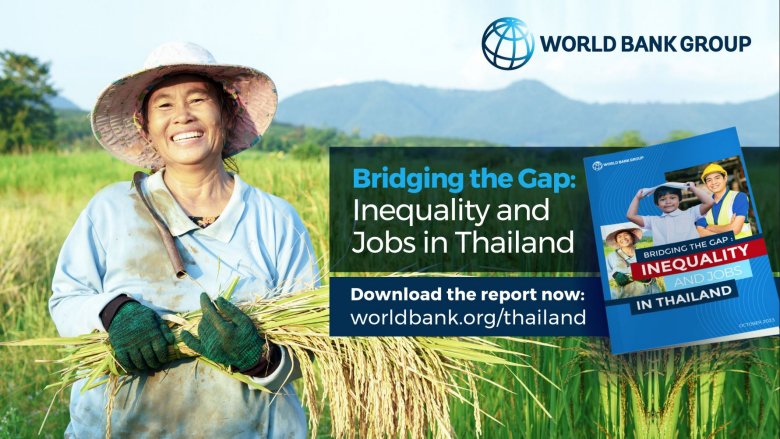Key Findings
- During the past two decades, Thailand has made progress towards reducing its significant levels of inequality. Yet inequality remains high. In 2021, with an income Gini coefficient of 43.3 percent, Thailand still had the highest level of income-based inequality in EAP, and it ranked as the 13th most unequal of the 63 countries for which income Gini coefficients are available. Inequality is particularly high when considering the concentration of income and wealth, as over half of the country’s wealth is held by the richest 10 percent of the population.
- Several structural factors contribute to the persistence of inequality. Inequality begins very early in life, with unequal opportunities in human development, and perpetuates over the life cycle and across generations. Inequalities based on household heads’ occupation and education level are the largest contributors to income inequality. Spatial disparities across and within regions also contribute to the persistence of income inequality. In 2020, the average per capita GDP in Bangkok was more than 6.5 times that of the Northeast region, which had the lowest GDP per capita in the country.
- Learning outcomes reveal the depth of the country's inequality of opportunity in education. Not only are students from poorer families disproportionately out of school at a young age, but those who do stay in school are less likely to reach age-appropriate grade levels, more likely to have worse learning outcomes, and less likely to reach tertiary education compared to their peers from wealthier families. Students’ scores from 2018 PISA reveal significantly higher learning outcomes for students from wealthier families for those from poorer ones. These inequalities reduce employment opportunities later in life for students from poorer families, constraining their prospects for upward mobility.
- COVID-19 exacerbated the existing gap in learning outcomes and household debt challenges. The pandemic is estimated to have widened the learning gap—the difference between the expected years of school and the learning-adjusted years of school—from 3.7 to 4 years, resulting in a loss of 1.22 learning-adjusted years of schooling. Between 2019 and 2021, the overall rate of indebted households increased from 45.2 percent to 51.5 percent as households had to borrow for income losses caused by the pandemic.
Policy priorities to address the structural causes of inequality can be structured around three groups: 1) building resilience, 2) setting the stage for a vibrant and inclusive economy, and 3) promoting greater equality of opportunity.
- Building resilience. In the short term, policy actions are needed to urgently address the lingering impacts of COVID-19, particularly learning losses and the rising prices of necessities, which could both widen human capital gaps. Policy measures can include support for schools and learning recovery, improve fiscal policy to strengthen social protection programs, targeting assistance to poor households, increasing revenue collection, and investing in education and health services to reduce inequality in both the short and long term.
- Setting the stage for a vibrant and inclusive economy. Policies to revitalize the Thai economy and make it more inclusive can focus on four key priorities: reskilling and upskilling the workers most affected by labor market disruptions; using education and training to build pathways to better jobs and help workers adapt to a rapidly-changing labor market; enhancing women’s participation in the labor market; and increasing farmers’ income.
- Promoting greater equality of opportunity. Policies to increase equality of opportunity in education should focus on enrolling poorer children in preschool, closing learning outcome gaps, supporting at-risk students to improve their academic performance and reduce dropout rates, and helping students’ transition to tertiary education. Consolidating and reorganizing small schools into larger, better resourced institutions can also help improve the equitable distribution of resources across schools. Reducing spatial disparities in access to basic services and infrastructure can help mitigate inequalities related to local circumstances.
